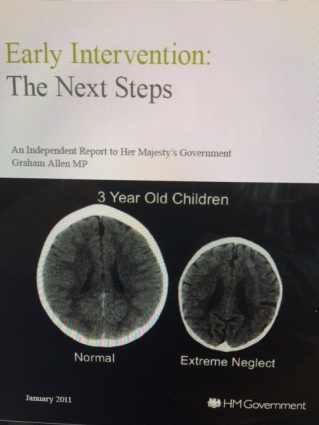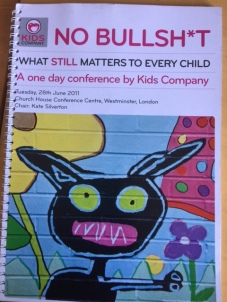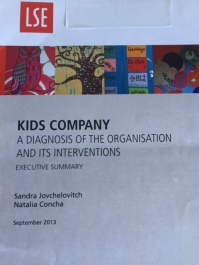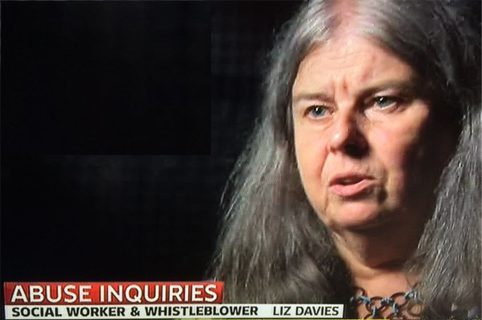In 2002, Prince Charles first gave Camila Batmanghelidjh, CEO of the former charity Kids Company, the idea of considering the impact of child abuse on children’s brain development. He presented her with 25 clinical papers on the topic. From that moment I was suspicious because the idea was so wide as to include the impact of all kinds of trauma making any research very confused in aim. Also, the method of research was to scan the brains of ‘troubled teenagers’ which seemed to be more about a social control agenda. I had already detected mixed messages about the aims of this children’s charity (Evening Standard: 11.09.2009).
Another Evening Standard article was more blatant about the project. ‘Scores of ‘hoodies’ will be tested on London Streets as scientists attempt to prove their brains have been scarred by abuse and neglect. The research could revolutionise the way extremely violent children are treated by authorities. Scientists will perform an electroencephalography scan in which 256 electrodes are placed on each child’s head to measure electric impulses coming out of the brain cells. They will also test blood, saliva, heart and respiration rates’ (Evening Standard 14.07.2009). I was perplexed. I’ve worked with many children traumatised by abuse and never felt the need to see a scan of their brains. If one of my medical colleagues had handed me a copy I would have had to ask why – because what would it actually tell me? How would this diagram help me understand how a child was experiencing the impact of abuse day by day? How would it tell me what they felt? One news article described the difference between a healthy child’s brain and the image of a three year old, ‘who suffered severe sensory deprivation with minimal exposure to language, touch and social interactions. This child’s brain is smaller, has enlarged ventricles [holes in the centre of the brain] and shows signs of cortical atrophy – shrinkage of the cortex, the outer layer of the brain’. Professor Fonagy, a psychologist at University College London, is cited as saying, ‘by using brain scans, rather than studying how children behave, we will be able to spot those who are in greatest need of intervention. This system ought to be more accurate than current methods of diagnosis, such as questionnaires and observation… infants cannot articulate neglect or abuse, but their brain images can’ (Carlowe [2007] ‘My Brain Mapper’. The Times. 12th May). I was witnessing the development of a depersonalised professional response to abused children which reduced children to biological entities and raised serious questions of children’s rights.
I later learnt of a London children’s social work team where children deemed to be ‘in need’ were chosen from a range of traumatised backgrounds to have their brains scanned by volunteers in a Kids Company van. The children were given a picture of their brain scan to take home. I supposed they showed it to their friends and even pinned it on the wall. I worried about what a child would think about their picture. Did they see themselves condemned for life as brain damaged? Did they think healing was possible? I found the whole concept depressing in the extreme. Dr Jan Macvarish of Kent University expressed her anxiety about the tests, ‘for a charity to be doing that with children about whose self-identity it was supposedly very concerned, to send them off for brain scans suggests that they have got brain damage’.
I couldn’t see how any research would make sense of the scans in relation to a wide range of childhood experience of being in need. It reminded me of my school where the nuns had a wallchart of all the souls in the class and coloured in black marks on them when we were naughty. As a child, I thought my soul was inside my body permanently stained because I’d worn the wrong shoes, been found in the playground without my hat on or in the street eating an ice-cream. It was of course emotionally abusive. Batmanghelidjh spoke of children who, ‘are different .. we think their brain has been altered by the amount of violence they have been subjected to’. She based her thinking partly on the work of Dr Bruce Perry who wrote, ‘The Boy who was raised as a dog’. However, he declared that his theories of the impact of maltreatment on a child’s brain related to children who had suffered very extreme malnourishment and neglect and were not meant to be applied across all forms of child abuse. He expressed concern that, that overstating and misunderstanding the neurobiology can lead to confusion, anger, distortion and potentially to bad policy. I attended conferences and heard arguments, based on neuroscience, for early intervention in vulnerable families to remove children at a very young age in order to avoid the alleged predictable and irretrievable brain damage. The philosophy probably had an influence on the promotion of the fast track adoption policy and risked serious over-intervention by the state in family life. John Breuer wrote about the Myth of the First Three Years and suggested that the application of neuroscience to child development was ‘politics disguised as science’ .

It was as if mechanistic knowledge of the structure of a child’s brain would inform us about a range of social problems such as urban violence or unemployment. This approach to prevention and early intervention has been strongly criticised by Wastell and White (2012) and Munro and Musholt (2013).
Macvarish (2015) is a harsher critic and argues, ‘Politicians and public-sector commissioners have also embraced this sort of neuro-bollocks in order to make the case for ‘early intervention’. The ‘first three years movement’, an alliance of politicians, policy advocates and academics who insist that social problems are caused by the experiences of early infancy, have used neurodeterminist arguments to demand state funding for interventions with toddlers, babies and even fetuses, all with the promise of saving money ‘down the line’ on adult services for the mentally ill, the criminal, the addicted, the unemployed and the under-educated. Such services will, it is promised, be rendered miraculously unnecessary once human suffering is eradicated at the source, not by eugenic sterilisation programmes, but by the neurological neutralisation of parental harm… Midwives, health visitors, social workers, foster carers and early-years workers are routinely shown pictures of ‘healthy’ and ‘damaged’ children’s brains, and told that their work supporting parents will not only guarantee the future emotional wellbeing of the nation, but revolutionise class differentials’.
In 2009, the Advertising Standards Authority criticised Kids Company for its advertisements. One showed 2 black teenagers harassing a white man and was said to be racist because of reinforcing negative stereotypes. Another advertisement stated, ‘you’re right kids who can kill really are wrong in the head’ beneath a picture of 4 black teenagers. It was ruled misleading in featuring claims about brain size and deemed likely to be offensive. This alerted me to the serious implications of defining children in terms of their brain development. The implied predictability of human behaviour based on physical characteristics risked being used in the discriminatory politics of exclusion.
I discovered that numbers of academic institutions were conducting the research and I thought of all the University Ethics Committees approving the projects. I learnt that their minutes are not in the public arena and therefore I couldn’t check out their reasons for approval. Most academic researchers are delighted if one institution takes up an idea but for so many different universities and hospitals to be involved at the same time, looking into very similar things, was strange indeed. Goslett (2016) reported that between 2007 and 2009, a total of 123 separate procedures were conducted on 10 young people – part of a joint venture between Great Ormond Street Hospital and University College London, and carried out by the Institute of Child Health. The tests, including MRI scans, tried to prove a link between mistreatment in childhood and violent tendencies in adulthood. This seemed more like a social control agenda to me and a far cry from portrayal of the research as aiming to be supportive of young people’s need to be safe from harm. The research proved inconclusive and was never published. No evidence of a link between the brain and antisocial behaviour was found. Despite this, dozens more teenage boys associated with Kids Company have taken part in scans and other tests through other institutions.
As part of the brain study programme, researchers from University College London attached electrical sensors to the heads of 80 teenage boys at charity’s youth centre in Kenbury, South London, to measure brain activity using EEG (electroencephalogram) analysis. Another 44 teenage youths from local schools also took part. Kids Company also helped recruit young people for a project run by King’s College London in which 70 teenagers underwent scans to determine whether childhood physical abuse can lead to abnormalities in the brain.
I wonder about these children now. Did they personally consent to the experiment? It is reported that parental consent was obtained in only 3 of the 10 cases. In a Freedom of Information response (12.12.13) by Great Ormond Street Hospital for Children NHS Foundation Trust to Ann McNeil (who has done many FOI’s on this topic), it was stated that, ‘where it was not possible to contact the child’s parent/carer, the child’s keyworker from the Kids Company signed the consent form. The project had full ethics approval’. Obtaining parental consent would not have been straightforward from the parents and carers of many children attending Kids Company projects given the complexity of their home lives. However, I questioned whether this was a conveniently useful cohort of disadvantaged children readily made available for testing? I became further concerned about ethical considerations. I was well aware of the known history of some children in care in many countries, including the UK, having been used for medical experimentation.
I tried to find out if having an MRI scan was in any way harmful to a child age 10 years. How could this be acceptable – administering this complex procedure to children for non-therapeutic reasons? However, no medical expert was able to tell me that the MRI itself was a risky procedure for a child. I was advised that it could be psychologically traumatic though, a view confirmed when I heard from a member of staff at Kids Company that they had been asked to accompany children and emotionally support them through the MRI scan process.
I then became aware of an academic article, a review of literature by Hart and Rubia, of Kings College Hospital, entitled ‘Neuroimaging of child abuse: a critical review’ which stated it was funded directly by Kids Company. This was a complex medical paper and was mostly incomprehensible to me. It stated, ‘Neuropsychological studies suggest an association between child abuse and deficits in IQ, memory, working memory, attention, response inhibition and emotion discrimination. Structural neuroimaging studies provide evidence for deficits in brain volume, gray and white matter of several regions, most prominently the dorsolateral and ventromedial prefrontal cortext but also the hippocampus, amygdala and corpis callosum….’
Batmanghelidjh launched a campaign to raise £1.6 million for the research. On the Kids Company website, a high-tech virtual brain invited donors to ‘sponsor a neurone’ by giving £5 to their neurone of choice. I wondered how many of them even knew what a neurone was but it all made me feel sick. Real live children can’t ever be reduced to a set of neurones. Batmanghelidjh’s guru status easily attracted public funding. Kids Company had over 44,000 different donors which included pharmaceutical companies. I began to wonder if there was some business agenda at play – to identify physical damage to brains and then to discover some sort of magic polyfilla to patch up the holes – this would surely be a hot-selling product given the scale of abuse. At the very least, the line of financial accountability was difficult to prove hindering any understanding of what the purpose of these projects really was. I was reminded of the practice of phrenology.

Krauss in her article MRI scans the new phrenology argued that physician Franz Gall sought to understand the minds of murderers and other criminals by feeling the outside of their skulls. This practice, first used in 1796, came to be called phrenology. It turned out that neither Gall nor anyone could systematically link the bumps and lumps on the head to any regular patterns of behaviour, criminal or otherwise. It was an early attempt to medicalise the causes of human behaviour which could then provide the state with a mechanism of social control.
I became fascinated with finding out more. I went to Kids Company conferences. One called ‘ Molecules of happiness – why love matters for vulnerable children’ (26th Sept 2013).
I listened to hours of scientists talking neuroscientific jargon and showing powerpoints of varying brain sizes and diagrams of brain dysfunction. I visualised a future where a class of children would be scanned and then divided into those who there was no point teaching because their brains were too damaged and those who would be predicted to be well behaved future citizens deserving of an education. My mind was spinning. At one conference ‘No Bullsh*t’ (28th June 2011) Camila Batmanghelidgh and her team handed out about 300 drums.

I shoved mine under the seat. She had somehow noted the rebellion and walked up to me instructing me to play along. I was fascinated how I’d been spotted in such a massive hall of people. The rhythmic drumming went on about half an hour (mine firmly back under the seat and my fingers in my ears). I was told afterwards that one person not playing the drum beats broke the rhythm. As people went for lunch their emotional levels were truly heightened. Of course not everyone shared my view. One member of the audience wrote that, ‘the audience members were then handed a West African drum each, and led through a revivifying lesson in bass and tone drum techniques which put a new spin on the concept of ‘working through’. The effect on 300 or so social workers and therapists of sustained drumming more or less in sync gave physical expression to the sense, pervading the conference, of the energy and potential of young people’.
I went to an art exhibition at the Royal Academy which had been in partnership with Kids Company since 2008. Amongst the crowds I didn’t see anyone I knew from the world of child protection or child care as I usually would expect at such an event. It was no wonder because those attending were business people and artists. I saw a grotesque life size sculpture of a child with a graphic image of torn out heart. It had a sign next to it referring to ‘insensitive stabs delivered by social services who failed to protect him..’. If any young person was thinking of disclosing abuse to the authorities they certainly wouldn’t do it after reading that. There should have been a statement from the Charity to put some balance. Most shocking was the constant stream of chattering classes who thought it was wonderful. I felt compelled to stand by this artwork declaring myself as a social worker who had protected many children – pathetic I agree, but I felt angry. I went about looking for children from the project – the artists – to speak with but I couldn’t find them. What I saw in the art work was not my experience of art by abused children. It felt staged e.g. a perfect trainer with a knife through it, a bed with models of spiders under it. When I did one of my Kids Company tours I went to the art department and had met the artists working on children’s art preparing items for fund raising activities. For instance children’s drawings were being put into egg sculptures to promote an Easter exhibition.
I had a friend who worked at the Kids Company Headquarters who took me on one of my tours. When we got in the lift she said, ‘don’t talk in here – everything is recorded’ – this was the second time I’d been told that and it was not what I expected from a children’s charity. I also went to a Kids Company talk where two huge bizarre sculptures stood on the stage. Following my friend’s comment, I fantasised that each was a camera filming audience reaction. I had to pinch myself at all the various events to remind myself that the charity was actually about young people. It just wasn’t the vibe. Everyone would be infantilised with bubbles to blow and little tiny cupcakes to eat but it felt false and at times sinister to me.

I became hungry to learn anything about the charity. I found the evaluation project by the London School of Economics which was a eulogy writing of ‘parenting by proxy’ a term which sent a chill through me as it certainly wasn’t defined by legislation. I had not heard of this term before. Kids Company, they said, would raise awareness about its model of ‘psychosocial scaffolding for re-writing fractured lives… fostering debate about the role of love and unconditional support in the management of developmental adversity and raise awareness of the negative impact of developmental adversity on brain, mind and society’. I looked for children’s voices in the research but it was solely a survey of the views of staff and volunteers.
So why should I write all this now? Now that the Kids Company website has gone and there is little trace online of all that occurred. History is being erased. I’m writing because during it’s demise, I began to question what had happened to the experiments. Have they been completed and published by the line-up of researchers and medical experts? Was it only Great Ormond Street that abandoned their project? What has happened to the children who were put through EEGs and MRI scans – how are they now? What did they think of their contribution to ‘science’ and what do they think now? Was there trauma involved in the process? Did they experience claustrophobia as they went through the MRI scanner tunnel? Have the ethics committees re-examined their decisions? Has the government reviewed the funding streams and academic decision-makers that enabled these research projects to go ahead? Was it all about taming teenagers? Was it about creating conditions ready-made for the Big Pharma to fill a gap in the market?
One thing social work taught me over 44 years is that human beings can and do survive the most horrendous childhoods and come through. I don’t believe that a brain scan has anything to contribute to our knowledge about trauma to children but I mainly think that children, already vulnerable, deserve better than to be guinea pigs in someone’s ludicrous experiment. The dust has now settled on what was the charity Kids Company – but what has happened to all that costly research? At a later date, the children as adult survivors will be asking for sure – but I’d like to know right now before more evidence about it vanishes entirely.

You must be logged in to post a comment.